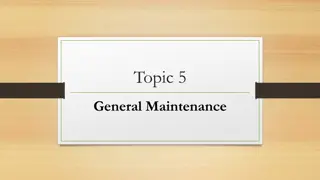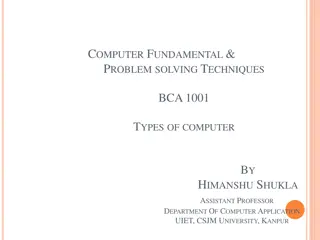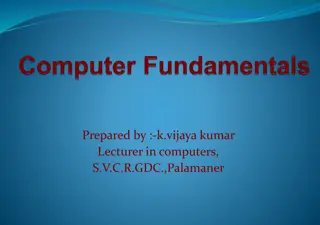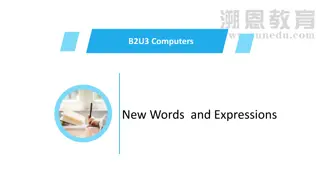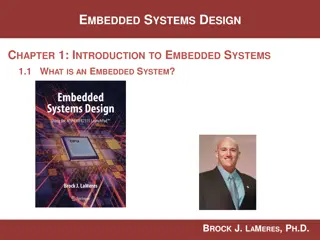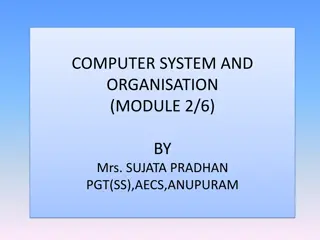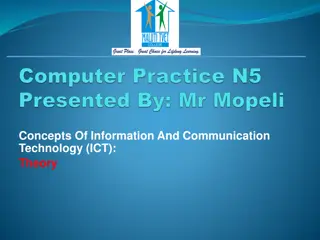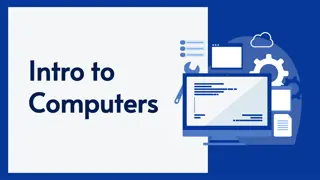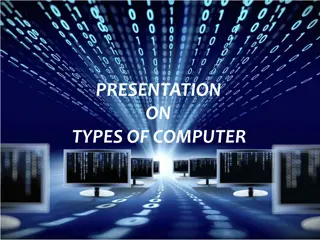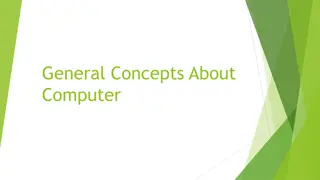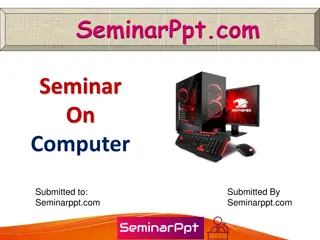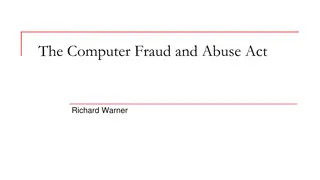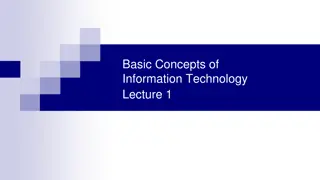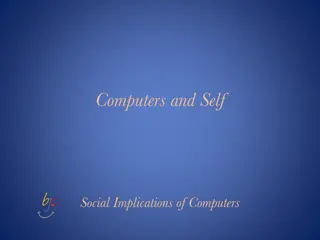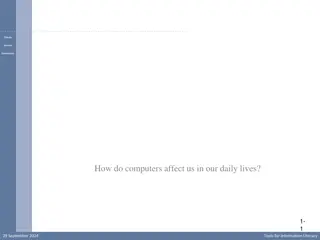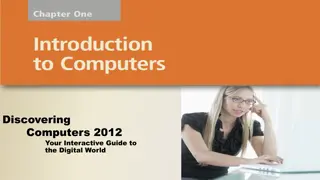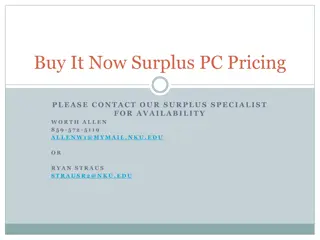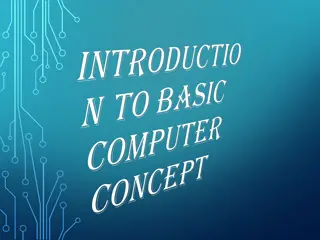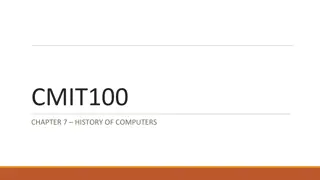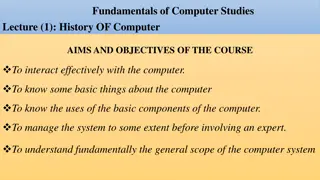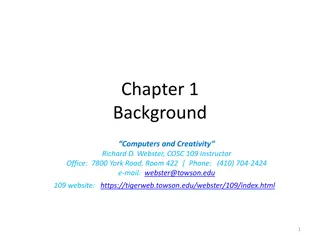
Understanding Computer Systems and Components
"Learn about the components of a computer system, including hardware and software. Explore input and output devices, the central processing unit (CPU), and their functions. Gain insights into the workings of a computer system in this informative guide."
Download Presentation

Please find below an Image/Link to download the presentation.
The content on the website is provided AS IS for your information and personal use only. It may not be sold, licensed, or shared on other websites without obtaining consent from the author. If you encounter any issues during the download, it is possible that the publisher has removed the file from their server.
You are allowed to download the files provided on this website for personal or commercial use, subject to the condition that they are used lawfully. All files are the property of their respective owners.
The content on the website is provided AS IS for your information and personal use only. It may not be sold, licensed, or shared on other websites without obtaining consent from the author.
E N D
Presentation Transcript
A system is anything that is made up of many parts all working together to meet a specific goal. A computer is any electronic device that converts data (raw facts) into information (processed data).
A computer system is made up of two parts: Hardware Hardware and Software. Software. Hardware These are the physical parts of the computer e.g printers, keyboard etc. Hardware e.g printers, keyboard etc. Software These are the programs (sets of instructions) that are used to run the computer e.g.Word processor, spreadsheet, database, presentation software etc. Software
1. Input Devices These are devices that are used to feed the computer with data for processing within. Examples include: Keyboard, mouse, scanners, digital cameras etc. 2. Output Devices These are devices that are used to give out information (processed data) from the computer to the user. Examples include: Monitors, Plotters, speakers etc. The output could take any of the following forms: Soft copy Hardcopy plotter, printer. Machine readable form using the computer e.g. information stored on disks. 1. Input Devices 2. Output Devices Soft copy-this is output that is shown on the screen. Hardcopy-this is information printed on paper e.g. from a Machine readable form- - this is output that can only be read
3. Central Processing Unit (CPU) This is the brain of the computer. It is where data is processed into information. The CPU contains the processor which comprises two parts: Arithmetic Logic Unit(ALU) and Control Unit(CU). However, there is a third part of the CPU, known as memory, though technically it can be considered as not being part of the CPU, since it is upgradeable. 3. Central Processing Unit (CPU)
Parts of the CPU. As stated previously, the CPU is made up of three parts, namely: Arithmetic Logic Unit The work of the ALU is to perform mathematical functions as well as do comparisons between units of data presented to it. Control Unit The work of the CU is to take data from an input device, to the processor/memory, then to an output device. Memory The work of memory is to store data before, during and after processing. Parts of the CPU. Arithmetic Logic Unit Control Unit Memory
Types of memory Memory comes in three forms: (a) Primary Memory. It is also known as main memory or primary storage or RAM (Random Access Memory). The work of this memory is to hold data, and processed information temporarily before it is saved onto hard disks, floppy etc. Therefore it only holds data at the time of processing only. Types of memory (a) Primary Memory.
Characteristics of Primary Memory 1. This memory is volatile depends on the supply of power to keep information. If power goes off, the contents of Ram also will disappear. 2. The user can read and write to this memory. This means that apart from reading what is there, you can also change, delete or manipulate the data in anyway you want. The user therefore has control over RAM. 3. Ram s capacity is always small, that is why it has to be supported, or augmented with secondary memory like Hard disks. Characteristics of Primary Memory volatile. This means that it
(b)Read Only Memory. Also simply known as ROM. This memory is used to store system programs (those programs which come already built into the computer) or simply firmware (programs that come hard wired in ROM). (b)Read Only Memory. firmware (programs that come hard wired in ROM).
Characteristics of ROM It is not volatile. This means that whether power goes off, the contents of ROM will not disappear. They are held there permanently. The user can only read the contents of ROM. He cannot delete, add or change anything stored in ROM. Rom capacity, compared to that of RAM is smaller. Characteristics of ROM
(c)Secondary Memory This type of memory is sometimes known as backing storage, or auxiliary storage. It is used to store processed information permanently for as long as the user wants to keep such information. The user can delete the contents of secondary memory and rewrite to it. Except in cases of CD s which are recordable only (CD-R). (c)Secondary Memory backing storage, or auxiliary storage.
Divisions of Secondary Memory Backing storage can be in the form of magnetic tapes or magnetic disks. The latter is mostly used because of its advantages over the former. Examples of magnetic tapes include, Reel-to- reel tapes, audio cassette size tapes used for data storage. Examples of magnetic disks include: hard disks, floppies, CD-R, CD-RW, flash disks, jazz disks, zip disks. Divisions of Secondary Memory
Parts of Computer Software Computer software is made up of two main categories namely: Parts of Computer Software System Software These are software that come already installed in your computer when you buy it. They are sometimes known as firmware. The following are the types of system software: System Software Operating System These are sets of programs that take over the control of the usage of computer hardware and software. They are like the driver of a vehicle and the rest of the software installed are like the passengers! Without the OS, you cannot use the application programs such as ms-word etc. The operating systems are either single user or multi user systems. Operating System
(a) Single user systems These are operating systems which can support only one user at a time. They cannot be used for simultaneous uses with more than one person at a time. They are either DOS based or Windows based systems. Examples of DOS are Ms-Dos, PC-Dos and OS/2.Examples of windows are: WIN 95/98/2000/XP (a) Single user systems (b) Multi These OS support more than one user at a time. They are used for networking computers for resource and information sharing. (b) Multi- -User Systems User Systems
ii. Translators These are programs which convert human language instructions (Source code) into machine language (Object code) for the computer to understand. They are mainly of two types: Compilers These translate a whole source program at once into object code. It is fast in translation, but only shows the errors after compilation. It is therefore not good at detecting errors. Interpreters These translate one line of source code to object code at a time. They are slow, but good at detecting errors. iii DBMS create, store and retrieve records from files. ii. Translators Compilers Interpreters iii DBMS- these are programs that are used to
(iv)Utilities service programs. They include functions such as copying disks, delete, formatting etc. Application Programs These are programs that the user purchases and installs in his computer. They are used to perform specific functions for the user. They are divided into two types: General (Generic or off the shelf) and Tailor made (Specialized software or Bespoke). (iv)Utilities- these are sometimes known as Application Programs
Tailor made software These are software that is specifically made for a particular purpose only. They go by different names such as bespoke or specialized software. Advantages of Custom Made Software It is for a one off problem It is used when there is no off the shelf software Can be tailored to existing hardware Will contain only desirable/useful routines Tailor made software Advantages of Custom Made Software Disadvantages Could contain many errors, takes long to perfect It is costly to develop software It is not immediately available and may take long to complete Maintenance cost of such programs is very high May not ultimately perform to expectations and may prompt several changes. Disadvantages
Generic Application Software These are software which are purchased off the shelf by anyone. They can be used by anyone to do specific functions within their area. Advantages of off Immediately available The development costs are shared i.e. you don t have to meet the cost of programming alone. The program is fully tested and the bugs (errors) are eliminated. Such programs are compatible with other software and do not create conflicts. Training courses for such packages are available with well trained staff. Generic Application Software Advantages of off- -the shelf the shelf Disadvantages May not contain all the routines wanted Sometimes contains too many routines which are undesirable by the user. . Disadvantages
There are many types under generic applications namely: Word processors These are programs that are used to process textual documents such as reports, letters etc.Examples are ms- word, word perfect, WordStar etc. Word processors Spreadsheets These are programs that are used to perform numerical computations such as additions, averaging etc.They are used to make projections or forecasting for the future. They are good at answering what if questions. Examples are ms-excel, lotus 1-2-3, SuperCalc etc. Spreadsheets Databases Also known as electronic filing cabinet. It is used to keep files, records in an orderly way. One can create files, forms, generate reports and also query the database. Examples are: ms-access, DBASE, FoxPro etc. Databases
Presentation Used to create slides for presentation/demonstration purposes. Example is ms-PowerPoint. Presentation Accounting This package is used to perform all the functions of accounting within the computer. Examples of functions include, making of balance sheets, profit and loss accounts etc.Examples of such packages are: Sage, QuickBooks, and Ms-Money etc. Accounting Desktop Publishers (DTP) Programs used for designing purposes. Designs for magazines, birthday cards are done using DTP.Examples include: Adobe, Ms-Publisher, CorelDraw etc. Desktop Publishers (DTP) Webpage Design Packages used for designing web sites. Examples are Dream weaver etc. Webpage Design Programming These are programs used to develop software. They are of different types. The general examples are: Pascal, Visual Basic etc. Programming

